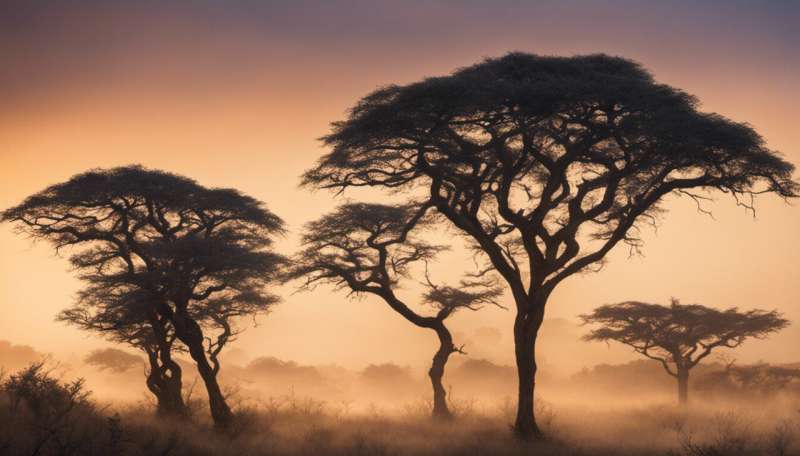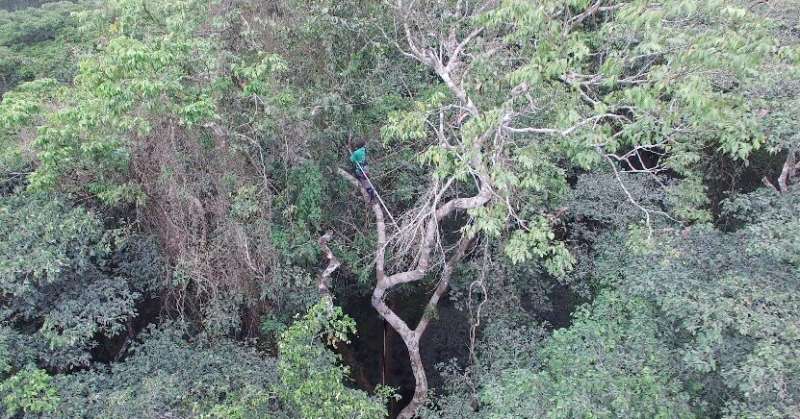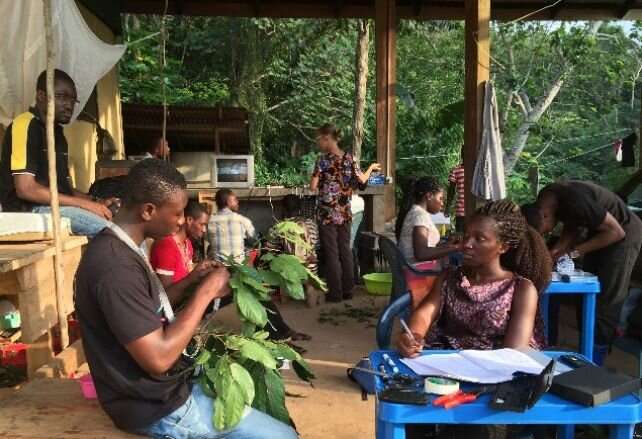A view on climate change from the treetops of Western Africa

The tropical forest canopy is one of the Earth's underexplored frontiers. To understand how these unique environments respond to climate change a team from the Ecosystems Lab at the University of Oxford and partner institutes in Ghana gathered evidence from the treetops, finding drier forests are at greater risks.
Our natural world is facing unprecedented changes in the distribution of biodiversity—the variety of life on earth—at local and global scales. Around one million species are threatened with extinction, posing an imminent threat to the functioning of ecosystems and to human wellbeing.
In our new study, recently published in Nature Communications, we investigate if and how climate change has affected the diversity of tropical ecosystems in West Africa over the last decades. In particular, we wanted to understand if wetter and drier tropical forests responded in different ways to the same drivers of change.
For this study we conducted fieldwork in Ghana over six months. The field campaign was led by Dr. Imma Oliveras and Dr. Stephen Adu Bredu and coordinated by co-authors Theresa Peprah and Agne Gvozdevaite. It formed part of a global effort. More than 25 research assistants from KNUST University and Forestry Institute of Ghana (FORIG) participated in the field campaign and were trained in the sampling techniques and scientific protocols for undertaking the research.

During the campaign we visited clusters of sample plots at three sites, stretching along a climate gradient from humid ancient rainforest through to parched try forest and savanna. We sampled leaves and branches from 299 trees. These were very long days, usually starting at 4.30 am with a group breakfast and by 6 a.m. we would be already working in the field. We would finish the fieldwork at around 3 p.m. and then work in the field laboratories until 10 pm. Some of the research assistants—who were masters and undergraduate students at the time—have pursued further postgraduate studies after the experience and successfully found scholarships in Ghana, Europe and the US.
When starting this research, we expected that a drying trend would be reflected in overall diversity decreases for all tropical forests. However, we found that forest communities in drier sites experienced on average stronger declines in functional, taxonomic and phylogenetic diversity across time than forest communities in wetter areas.
This means that drier forests are transitioning towards increasingly more homogenous forest communities, diverging further from wetter forests in functional, taxonomic and phylogenetic diversity. In contrast, wetter forests showed on average increases in functional and taxonomic diversity, which could be the result of their higher atmospheric and ground water availability in comparison to that available for drier forests. Overall, climatic and soil conditions partly explained the changes in diversity and differences in responses between drier and wetter tropical forests in West African.

Stephen Adu-Bredu and Theresa Peprah from CSIR-Forestry Research Institute of Ghana, described that some of the most challenging things to do during the fieldwork were waking up daily at 3 a.m. in order to get to the field around 4 a.m. for predawn water potential measurements, as well as climbing of the trees at this hour of the day. They say: "The dry season CO2 exchange measurement was difficult and frustrating. One can spend over an hour or even a day on a single leaf, and the measurements are to be carried on three leaves per branch, as the protocol demands."
Dr. Imma Oliveras, senior study author and deputy programme leader on ecosystems at the Environmental Change Institute, University of Oxford, reflects on the field campaign: "To me this field campaign was an incredible enriching experience. These were busy days of knowledge exchange. I would be training local students on scientific methodologies, and they were teaching me about the local flora as well as about the local forests and of the Ghanaian culture and traditions.
"Some forests had taboo days in which we were not allowed to go to the forest and we would use for catching up on lab work. We would also exchange knowledge in other aspects, such as cuisine. I learned to make fufu and I taught them to cook Spanish omelets. Scientifically, I enjoyed training the research assistants in both data collection, data curing and data analyses, and most participants are now co-authors of other related research."

In our study we did not assess on how diversity changes affect ecosystem functioning. However, there is ample evidence showing that decreases in functional, taxonomic and phylogenetic diversity could cause loss of forest functions, such as resources uptake, cycling and biomass production and resilience to a changing climate. Therefore, the ecosystem functions of communities that show decreases across all three facets of diversity could be especially vulnerable under a drying climate.
Overall, our study found that drier forest communities have undergone biodiversity homogenisation due to a warming and drying climate, which could ultimately have negative impacts not only on the functioning of ecosystems but also on their contribution to people's wellbeing and livelihoods.
More information: Jesús Aguirre-Gutiérrez et al. Long-term droughts may drive drier tropical forests towards increased functional, taxonomic and phylogenetic homogeneity, Nature Communications (2020). DOI: 10.1038/s41467-020-16973-4
Journal information: Nature Communications
Provided by University of Oxford




















